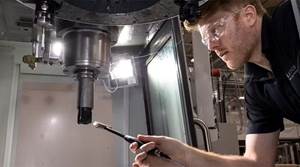Digital Manufacturing Hinges on Connecting the Machine Tool
The promise of digitally integrated manufacturing is using data to improve processes. Connecting machines is the key.
Share





In the telecommunications industry, the “last mile” is a common figure of speech denoting the final leg or branch of a network that ultimately reaches the end-user customer. Making this connection is typically the most difficult and most expensive portion of the network to complete. In factories and manufacturing plants, the connection to individual machine tools and shopfloor devices is much like this last mile, although the physical hookup is likely to span a short distance—the “last 10 feet” as I have chosen to call it. It’s what it takes to get the wiring cable to the communications port as well as establish an interface with the electronics for data access.
The analogy to the last mile is not exact, but it serves to make the point that this connection to individual pieces of shop equipment shares significant characteristics with the culmination of a telecommunication system. It’s essential; it can be complicated; it is sometimes misunderstood; it is often overlooked or underestimated by proponents of grand factory-of-the-future concepts. Yet without it, the Industrial Internet of Things is hobbled.
Paradoxically, this connection is at once the starting point and the ending point of the factory- wide/company-wide network. At the start, this connection taps into the most vital aspects of the manufacturing process, at least in metalworking. What is the machine and all of its mechanical components, its control unit, the cutting tool, and every accessory or auxiliary device doing at every moment a part is being produced? Recording, gathering and transmitting the pertinent information from this source is the purpose of connecting the machine to the network. Ultimately, the benefit is that this information results in changes to improve the performance of the machine, its control, the cutting tool and so on. Ideally at the end, these changes are communicated and executed by the same network that retrieved the information in the first place. It’s a loop—a loop that enables a virtuous cycle potentially extending as far across the supply chain as can be implemented.
Quite a few shops have already made this connection to many of their machines or manufacturing assets. In most cases, the resulting network is primarily used for data collection and machine monitoring within the shop. This fact proves that the difficulties and complexities of these connections are surmountable, at least to a substantial and justifiable degree. Shops with active machine monitoring systems are closing the loop by initiating setup reduction efforts, improving programming methods, focusing training efforts more effectively and so on. This is a great start and perhaps the best first step to digitally integrated manufacturing.
But it is only a start. Many upstream uses of machine data are yet to be explored and exploited by these network users. Integrating with other management systems such as scheduling software and resource planning applications is one example. Predictive maintenance is also on the horizon. And network security is a constant cause for vigilance.
Also be aware that many developers of large-scale systems for connecting manufacturing operations on a corporate level seem to be missing the utilities and capabilities for the needed shopfloor connections. For them, apparently, the “last 10 feet” is a gap they are either overlooking or are unaware of. Whenever I receive news of startups claiming to have Industry 4.0 solutions, I check for provisions to integrate shopfloor equipment. These provisions are usually missing or undisclosed. This missing link can’t be ignored for long. Getting to the telephone pole nearest the house, so to speak, is not good enough.
I am hopeful. The inspiration for this commentary came from hearing the expression the “last mile” in recent discussions of digital manufacturing. Whether connecting machines is seen as a starting point, an ending point or a link in the loop, it now seems to be getting the attention it deserves.
Related Content
How to Mitigate Chatter to Boost Machining Rates
There are usually better solutions to chatter than just reducing the feed rate. Through vibration analysis, the chatter problem can be solved, enabling much higher metal removal rates, better quality and longer tool life.
Read MoreContinuous Improvement and New Functionality Are the Name of the Game
Mastercam 2025 incorporates big advancements and small — all based on customer feedback and the company’s commitment to keeping its signature product best in class.
Read MoreCutting Part Programming Times Through AI
CAM Assist cuts repetition from part programming — early users say it cuts tribal knowledge and could be a useful tool for training new programmers.
Read MoreHow this Job Shop Grew Capacity Without Expanding Footprint
This shop relies on digital solutions to grow their manufacturing business. With this approach, W.A. Pfeiffer has achieved seamless end-to-end connectivity, shorter lead times and increased throughput.
Read MoreRead Next
Last Chance! 2025 Top Shops Benchmarking Survey Still Open Through April 30
Don’t miss out! 91ÊÓƵÍøÕ¾ÎÛ's Top Shops Benchmarking Survey is still open — but not for long. This is your last chance to a receive free, customized benchmarking report that includes actionable feedback across several shopfloor and business metrics.
Read MoreMachine Shop MBA
Making Chips and 91ÊÓƵÍøÕ¾ÎÛ are teaming up for a new podcast series called Machine Shop MBA—designed to help manufacturers measure their success against the industry’s best. Through the lens of the Top Shops benchmarking program, the series explores the KPIs that set high-performing shops apart, from machine utilization and first-pass yield to employee engagement and revenue per employee.
Read MoreAMRs Are Moving Into Manufacturing: 4 Considerations for Implementation
AMRs can provide a flexible, easy-to-use automation platform so long as manufacturers choose a suitable task and prepare their facilities.
Read More




















